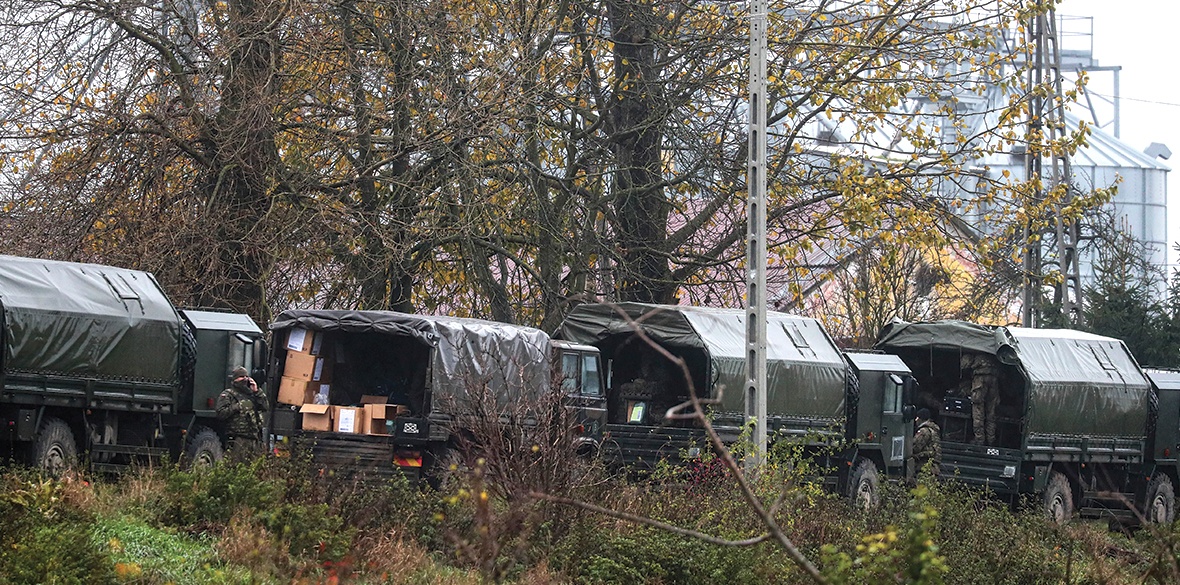This is the last article you can read this month
You can read more article this month
You can read more articles this month
Sorry your limit is up for this month
Reset on:
Please help support the Morning Star by subscribing here
LINDSEY GERMAN’S timely article The Polish missile crisis underlines the need to end this war now shows precisely why a daily paper for peace and socialism has never been more vital.
While the mainstream media led the charge toward World War III the Morning Star provided a lone voice of sanity.
Now that the initial knee-jerk calls for “closing the skies” retribution are being replaced by “It’s an unfortunate accident,” it’s important to point out that Polish and Nato forces possibly knew immediately after the explosion in Przewodow that the missiles had been fired by the Ukrainians, since the border area is under such strict surveillance.
Probable too is that US intelligence deliberately planted disinformation in the mass media to avert a public relations disaster.
On the knife-edge of an escalating conflict, not only did Western media act as the sirens of war for hours but the leaders of the Nato war coalition, one of the key actors in this proxy war, must also have sat on this information while Russian spokespeople made firm and ultimately credible refutations.
It seems that only the Kiev regime is denying culpability.
The initial English-language report on Tuesday about the incident, which happened around 4pm Polish time, was from Associated Press, a news agency which is often used to spread US intelligence-sourced stories.
Datelined Warsaw, it stated that “a senior US intelligence official says Russian missiles crossed into Nato member Poland, killing two people.”
This anonymous US intelligence statement came before Poland’s own government had made a statement. This came near midnight on Tuesday, eight hours after the explosion.
According to Reuters on that same Tuesday, Pentagon spokesperson Brigadier General Patrick Ryder told a Washington news briefing: “We are aware of the press reports alleging that two Russian missiles have struck a location inside Poland near the Ukraine border. I can tell you that we don’t have any information at this time to corroborate those reports and are looking into this further.”
But the “press reports” — note how many times US officials respond to press reports originally planted by other US officials — had come from someone of seniority in US intelligence, so it’s simply impossible to believe that the Pentagon did not have access to the same information planted by US intelligence in AP.
On Wednesday, AP were forced to issue a correction: “Warsaw, Poland (AP) — In earlier versions of a story published November 15, 2022, The Associated Press reported erroneously, based on information from a senior American intelligence official who spoke on condition of anonymity, that Russian missiles had crossed into Poland and killed two people. Subsequent reporting showed that the missiles were Russian-made and most likely fired by Ukraine in defence against a Russian attack.”
This is a fairly common method of news management by US intelligence agencies, first leak misinformation ahead of about-to-break negative news, use these misleading reports to confuse the public about the actual facts, then suggest the need to investigate further, while the original act, and its associated lies, drift out of the news cycle. Even now, it is still unclear whether it was a single missile or two.
The Polish-Ukrainian border is one of the most heavily monitored in the world.
CNN reported that a Nato official admitted that the missile been tracked before it landed in Poland. “Intel with the radar tracks [of the missile] was provided to Nato and Poland.”
It’s probable that the missile trajectory was being monitored in real time. Of course, in the modern era of satellite surveillance, radar is not the only means of monitoring missile attacks.
In March this year, Nato noted that it has a dedicated German-based fleet of such airborne warning planes: “The fleet is currently involved in assurance measures that followed Russia’s illegal and illegitimate annexation of Crimea in 2014, as well as in tailored assurance measures to Turkey. In addition, following Russia’s invasion of Ukraine in February 2022, the fleet is currently monitoring Nato airspace in order to assure and protect Allies.
“Nato operates a fleet of Boeing E-3A Airborne Warning & Control System (AWACS) aircraft, with their distinctive radar domes mounted on the fuselage, which provide the Alliance with air surveillance, command and control, battle space management and communications. Nato Air Base (NAB) Geilenkirchen, Germany, is home to 14 AWACS aircraft.
“The active surveillance sensors are located in the radar dome (‘rotodome’), which makes the AWACS such a uniquely recognisable aircraft. This structure rotates once every 10 seconds and provides the AWACS aircraft with 360-degree radar coverage that can detect aircraft out to a distance of more than 215 nautical miles (400 kilometres).
One aircraft flying at 30,000 feet has a surveillance area coverage of more than 120,000 square miles (310,798 square kilometres, or about the size of Poland) and three aircraft operating in overlapping, co-ordinated orbits can provide unbroken radar coverage of the whole of Central Europe.”
Even before this, Poland was a key element in Nato’s preparations. In June 2019, Poland hosted a major two-week long Nato exercise entirely devoted to Surface-Based Air Defence (SBAD).
According to a press release from Nato’s Allied Air Command Public Affairs unit: “The Polish Armed Force are hosting Allied SBAD sensors, shooters and control systems from the Czech Republic, Estonia, France, Germany, Hungary, Latvia, Lithuania, the Netherlands, Romania, Slovakia, the United Kingdom and the United States and observers from Bulgaria, Denmark, Italy, Norway and Portugal. Nato Allied Air Command, the Combined Air Operations Centres at Uedem and Torrejon and the Nato Communications and Information System Agency as well as the Nato Airborne Early Warning and Control Force will provide overall command and control support.”
Perhaps the other piece in the puzzle was the quick media shift from “Russian missile” to “Russian-made missile.” Speculation is that this almost certainly refers to the Soviet-era S300 missile system.
Ukraine’s S300 stock was inherited from the former Soviet Union but as Russia knocked out a number of these systems, Ukrainian leader Volodymyr Zelensky in his March 16 message to the US Congress, asked specifically for more of the long-range missiles. “You know what kind of defence systems we need: S300 and other similar systems,” Zelensky pleaded.
Sure enough, extra supplies of the S300 systems were acquired – from Nato member Slovakia. As the New York Times reported on April 14, Hiding in Plain Sight, a Soviet-Era Air Defence System Arrives in Ukraine: “Encouraged by the United States, Slovakia ‘donated’ a bulky but effective S300, hoping to challenge Russian domination of the skies in the war next door.”
While Russia claimed to have quickly knocked out a foreign-supplied S300 system both Ukraine and Slovakia denied that this was the case.
Bulgaria and Greece are two other Nato members with S300 stocks. Bulgaria, however, has so far publicly rejected US requests to hand them over to Ukraine.









